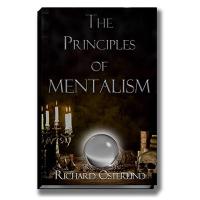Principles of Mentalism
Osterlind, Richard
Richard Osterlind
(Based on 1 review)

Do audiences really want to see experts and how do pseudo-demonstrations of NLP and psychology destroy the charm of mentalism?
How does technology affect mystery and why is the biggest mistake in mentalism the use of hidden computers and electronic gadgets?
Richard Osterlind is indisputably one of the top figures in mentalism today. He has performed internationally for the business and social elite for over 40 years and is recognized as one of the most sought-after entertainers in his field. Professionals worldwide use his material and his top-selling books and videos rate among the most acclaimed and successful in the industry.
Inside the pages of this remarkable book, Richard shares his secrets on all aspects of performing. Learn how to make your mentalism more commercial and powerful than you would have believed! Learn the secrets of effectively developing your performing style and how to deliver what people pay to see! Richard will even teach you what to think during your performance and why this is so vital!
Meant as a companion to Richard's monumental work, The Principles of Magic, this book may be his most provocative and insightful work to date.
Some of the chapters inside this remarkable book include:
- What the audience sees first.
- What are the different levels of mystery?
- How to properly use uncertainty, tension, surprise, elation, exhaustion, humor and release.
- The secret of the remarkable Power Silent Script.
- Why procedures are not problematic and how they are actually beneficial to your mentalism.
- The practical selection of effects.
- Why levels of ability are so important.
- ...and much, much more.
Pages: 86 - 5.5" x 8.5" - Softcover - Perfect Bound
Reviews
(Top ▲)
I love theory books. I know I’m in the minority, as most magicians want a book with tricks in it, if they even want a book at all. I also love mentalism. While I’m not a mentalist, I do have a large amount of mentalism in my repertoire that I make my living with. I say this because this book should be a match made in heaven for me. It honestly wasn’t. I found myself disagreeing and arguing with the book on almost every page.
The problem with most theory books is that the author writes as if his views and discoveries are gospel, and not open to discussion. Some of the best magic theorists like Eugene Burger, Robert Neale, and David Parr write their books from their perspective. They don’t say, “We,” instead they say, “I.”
Osterlind however, throws all his thoughts out as if they are inarguable facts. He constantly tells us what we should and shouldn’t be doing, and contradicts himself most of the time. In the book, he tells us we should be sure our prediction should be visible to everyone, without needing a spectator to read it. However, on one of his DVDs I’ve seen, he says it’s ok to do a nailwriter effect on stage as long as the spectator reads out loud the prediction.
He also makes proclamations that make no sense. For example, he claims the audience doesn’t want to see someone trained in NLP, body language, and psychology. He explains the apparent demonstration of those skills destroys the charm of mentalism. While I agree that many mentalists over explain their apparent use of these techniques, he’s making a HUGE mistake here, because he is ignoring the fact that Derren Brown uses this approach, and he’s the most successful mentalist in the world.
As much as I strongly disagreed with this book, I did learn a lot from it. It made me question my feelings about magic and mentalism, and I did come away with some interesting ideas to apply to my work, and experiment with. It was also an education to argue with a book and see if my own thoughts and feelings about the art hold up. So while this book fulfilled its purpose, it could have been less preachy, and less one sided. If he had simply stated that this was how he felt, and not gospel, I would have enjoyed it much more. No one can take an entire performance art, and state that their opinion is the be all end all way to perform it.
If you have a strong sense of who you are and what your art is, then I think you may get something out of this book. If you are just starting out, I’d strongly recommend “Maximum Entertainment” by Ken Weber, and “Audience Management” by Gay Ljungberg. Read both of those long before you even think of coming close to this book.
The problem with most theory books is that the author writes as if his views and discoveries are gospel, and not open to discussion. Some of the best magic theorists like Eugene Burger, Robert Neale, and David Parr write their books from their perspective. They don’t say, “We,” instead they say, “I.”
Osterlind however, throws all his thoughts out as if they are inarguable facts. He constantly tells us what we should and shouldn’t be doing, and contradicts himself most of the time. In the book, he tells us we should be sure our prediction should be visible to everyone, without needing a spectator to read it. However, on one of his DVDs I’ve seen, he says it’s ok to do a nailwriter effect on stage as long as the spectator reads out loud the prediction.
He also makes proclamations that make no sense. For example, he claims the audience doesn’t want to see someone trained in NLP, body language, and psychology. He explains the apparent demonstration of those skills destroys the charm of mentalism. While I agree that many mentalists over explain their apparent use of these techniques, he’s making a HUGE mistake here, because he is ignoring the fact that Derren Brown uses this approach, and he’s the most successful mentalist in the world.
As much as I strongly disagreed with this book, I did learn a lot from it. It made me question my feelings about magic and mentalism, and I did come away with some interesting ideas to apply to my work, and experiment with. It was also an education to argue with a book and see if my own thoughts and feelings about the art hold up. So while this book fulfilled its purpose, it could have been less preachy, and less one sided. If he had simply stated that this was how he felt, and not gospel, I would have enjoyed it much more. No one can take an entire performance art, and state that their opinion is the be all end all way to perform it.
If you have a strong sense of who you are and what your art is, then I think you may get something out of this book. If you are just starting out, I’d strongly recommend “Maximum Entertainment” by Ken Weber, and “Audience Management” by Gay Ljungberg. Read both of those long before you even think of coming close to this book.









